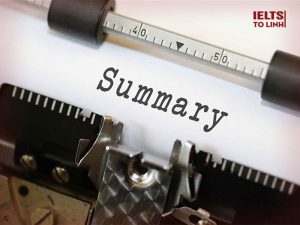Trong quá trình học IELTS và đặc biệt là đối với kỹ năng Reading, điền từ vào đoạn văn summary là một dạng câu hỏi khá “khoai” không chỉ với những bạn mới học IELTS mà kể cả những bạn đã học lâu. Nó đòi hỏi bạn phải nhận biết được đoạn văn summary là ý chính của đoạn văn nào trong bài đọc, bên cạnh đó còn đòi bạn phải có một vốn từ vựng khá để có thể nhận biết được các IELTS Reading synonyms được dùng trong đoạn summary. Sau đây là các bước hướng dẫn bạn để hoàn thành đoạn văn summary.

Bước 1: Hãy làm câu hỏi dạng này sau cùng, câu hỏi dạng đoạn văn tóm tắt sẽ dễ hơn sau khi bạn đã làm quen với bài đọc chính thông qua các câu hỏi trước đó. Nếu bạn dành toàn bộ thời gian để ngồi mò từng đoạn thì bạn sẽ vẫn ra được đoạn cần tìm, nhưng như vậy sẽ mất thời gian nhiều hơn và sau khi hoàn thành đoạn văn bạn lại phải ngồi đọc lại nội dung một lần nữa cho các câu hỏi còn lại trong bài. Nên cách tối ưu nhất đó chính là làm các câu hỏi dạng khác trước và tóm tắt nội dung chính của từng đoạn văn bằng 2, 3 chữ bên ngoài lề để các bạn dễ xác định phần cần tìm khi làm đoạn văn summary.
Bước 2: Cần lưu ý rằng, đây là dạng câu hỏi dùng để phân loại điểm, nên việc dùng scan và skim sẽ chỉ làm bạn tốn thêm thời gian mà chưa chắc tìm được câu trả lời đúng. Ví dụ: Nếu sử dụng scan và skim trong ví dụ ở bước 3, các bạn sẽ rất dễ bị câu mở đầu của đoạn summary và các synonyms trong đoạn summary đánh lừa. Nên để nhận biết được đúng đoạn văn nào trong bài đọc chính match với nội dung đoạn tóm tắt, hãy dành thời gian đọc thật kỹ và nắm ý chính của đoạn tóm tắt.
Bước 3: Xác định xem các từ cần điền ở dạng nào, verb, adj, noun, etc.
Bước 4: Xác định đoạn các đoạn văn có liên quan đến đoạn tóm tắt:
Hãy xem ví dụ bên dưới (Link cả bài reading)
Complete the summary below of the first two paragraphs of the Reading Passage.
Choose ONE OR TWO WORDS from the Reading Passage for each answer.
Write your answers in boxes 30-36 on your answer sheet.
SUMMARY
Example ….
From the point of view of recycling, paper has two advantages over minerals and ………..oil……….
in that firstly it comes from a resource which is ……………. and secondly it is less threatening to our environment when we throw it away because it is …………. Although Australia’s record in the re-use of waste paper is good, it is still necessary to use a combination of recycled fibre and ……………. to make new paper. The paper industry has contributed positively and people have also been encouraged by ……………… to collect their waste on a regular basis. One major difficulty is the removal of ink from used paper but ……………… are being made in this area. However, we need to learn to accept paper which is generally of a lower ……………… than before and to sort our waste paper by removing …………….. before discarding it for collection.
Dành thời gian đọc qua đoạn văn trên, các bạn sẽ thấy nội dung chính của nó được bao gồm trong 2 đoạn văn sau trong bài đọc chính (Phần màu xanh dương là của đoạn đầu và phần màu cam của đoạn thứ 2):
Paper is different from other waste produce because it comes from a sustainable resource: trees. Unlike the minerals and oil used to make plastics and metals, trees are replaceable. Paper is also biodegradable, so it does not pose as much threat to the environment when it is discarded. While 45 out of every 100 tonnes of wood fibre used to make paper in Australia comes from waste paper, the rest comes directly from virgin fibre from forests and plantations. By world standards this is a good performance since the world-wide average is 33 per cent waste paper. Governments have encouraged waste paper collection and sorting schemes and at the same time, the paper industry has responded by developing new recycling technologies that have paved the way for even greater utilization of used fibre. As a result, industry’s use of recycled fibres is expected to increase at twice the rate of virgin fibre over the coming years.
Already, waste paper constitutes 70% of paper used for packaging and advances in the technology required to remove ink from the paper have allowed a higher recycled content in newsprint and writing paper. To achieve the benefits of recycling, the community must also contribute. We need to accept a change in the quality of paper products; for example stationery may be less white and of a rougher texture. There also needs to be support from the community for waste paper collection programs. Not only do we need to make the paper available to collectors but it also needs to be separated into different types and sorted from contaminants such as staples, paperclips, string and other miscellaneous items.
Bước 5: Dò đoạn văn summary theo nội dung đoạn văn trong bài đọc chính và xác định từ cần điền. Nên nhớ, đoạn văn summary chỉ tóm tắt lại các ý chính và lượt bỏ các ý không cần thiết, nên khi dò đoạn văn để tìm từ cần điền phải dò theo nội dung và dựa vào dạng từ cần điền (đã xác định ở bước 3) đề tìm từ cần điền. Theo đó ta có:
From the point of view of recycling, paper has two advantages over minerals and 0- (n) oil. In that firstly it comes from a resource which is 1- (adj) sustainable and secondly it is less threatening to our environment when we throw it away because it is 2- (adj) biodegradable. Although Australia’s record in the re-use of waste paper is good, it is still necessary to use a combination of recycled fibre and 3- (n) virgin fibre to make new paper. The paper industry has contributed positively and people have also been encouraged by 4- (n) government to collect their waste on a regular basis. One major difficulty is the removal of ink from used paper but 5- (n) advances are being made in this area. However, we need to learn to accept paper which is generally of a lower 6- (n) quality than before and to sort our waste paper by removing 7- (n) contaminants before discarding it for collection.
Paper is different from other waste produce because it comes from a sustainable resource: trees. Unlike the minerals and oil used to make plastics and metals, trees are replaceable. Paper is also biodegradable, so it does not pose as much threat to the environment when it is discarded. While 45 out of every 100 tonnes of wood fibre used to make paper in Australia comes from waste paper, the rest comes directly from virgin fibre from forests and plantations. By world standards this is a good performance since the world-wide average is 33 per cent waste paper. Governments have encouraged waste paper collection and sorting schemes and at the same time, the paper industry has responded by developing new recycling technologies that have paved the way for even greater utilization of used fibre. As a result, industry’s use of recycled fibres is expected to increase at twice the rate of virgin fibre over the coming years.
Already, waste paper constitutes 70% of paper used for packaging and advances in the technology required to remove ink from the paper have allowed a higher recycled content in newsprint and writing paper. To achieve the benefits of recycling, the community must also contribute. We need to accept a change in the quality of paper products; for example stationery may be less white and of a rougher texture. There also needs to be support from the community for waste paper collection programs. Not only do we need to make the paper available to collectors but it also needs to be separated into different types and sorted from contaminants such as staples, paperclips, string and other miscellaneous items.
Bước 6: Kiểm tra lại đáp án. Ở bước cuối cùng này các bạn hãy xem lại xem mình đã điền đúng dạng từ chưa và các đáp án có làm thay đổi nội dung đoạn văn được tóm tắt hay không và cũng đừng quên kiểm tra chính tả nhé. Lưu ý: Tất cả đáp án của bạn nằm ngay trước mắt bạn, nên đừng tạo ra đáp án của riêng bạn nhé, vì dù bạn có dùng synonym của đáp án đi nữa, câu trả lời của bạn cũng sẽ bị gạch vì bạn đã không theo đúng yêu cầu của đề bài “Choose ONE OR TWO WORDS from the Reading Passage for each answer.”
Tóm lại, đây là một dạng câu hỏi khó; nó khó ở chỗ đòi hỏi các bạn gần như phải chạy đua với thời gian, vừa đọc hiểu đoạn văn bị khuyết đã được viết lại, tìm đúng đoạn văn gốc và tìm từ cần điền từ đoạn văn gốc đó. Tất cả phải diễn ra trong một thời gian rất ngắn và nếu bạn hấp tấp, vội vàng và thiếu bình tĩnh, chắc chắn bạn sẽ sai. Nên để làm tốt dạng bài này, cô khuyên các bạn hãy dành nhiều thời gian hơn cho việc tập đọc và tăng tốc độ đọc hiểu của mình lên nhanh nhất có thể nhé.
Đây là một bài viết cụ thể về dạng đoạn văn Summary trong IELTS Reading, dĩ nhiên, chúng ta đều biết Reading không chỉ có mỗi dạng này đúng không nào. Vậy thì đối với cách làm True/False/Not given thì sao, đây là dạng câu hỏi rất “khó xơi” đối với nhiều bạn, thế nên Linh đã cập nhật cho các bạn làm thế nào để chinh phục dạng câu hỏi không mấy dễ chịu đó rồi, các bạn xem ngay nha.
Trần Tố Linh












